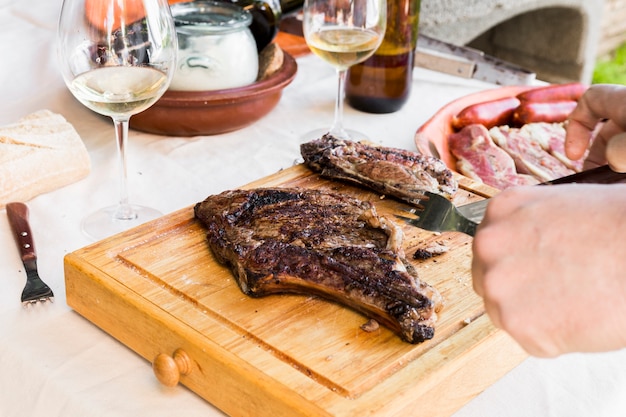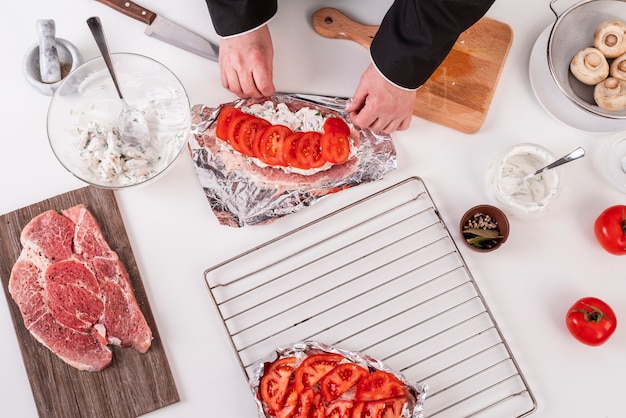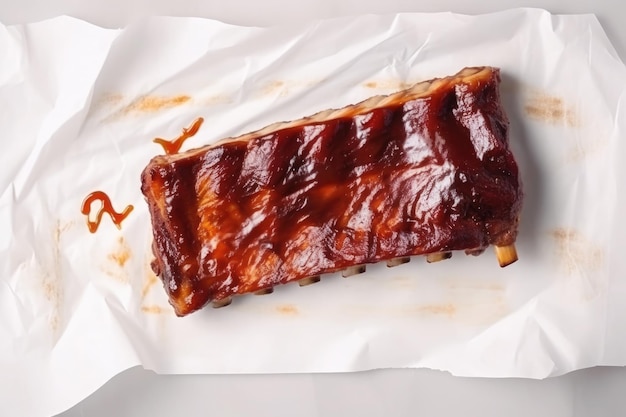Let's face it, there's something undeniably captivating about beef short ribs. They're not just a cut of meat, they're an invitation to culinary exploration. I've become quite the short rib enthusiast lately, and I'm here to share my passion with you. These bad boys are the epitome of comfort food, bursting with flavor and boasting that melt-in-your-mouth tenderness that's simply irresistible. But achieving that perfect short rib requires a bit of know-how, and that's where this guide comes in. I'm going to take you on a journey, from selecting the ideal cut to crafting a dish that'll have your taste buds singing. So, grab your apron, put on your favorite tunes, and let's get cooking!
(Part 1) The Beef Short Rib: A culinary gem

Now, you might be thinking, "Short ribs? Aren't those just the bones?" Well, yes, they do have a significant amount of bone, but that's precisely what makes them so special. Those bones contribute a unique depth of flavor and help retain moisture as the ribs cook, resulting in an extraordinary eating experience. And I'm not talking about tough, chewy meat here. No, no, no! Short ribs, when cooked properly, are unbelievably tender, almost disintegrating with a gentle nudge.
Delving into the Different Cuts
First things first, let's talk about choosing the right cut. The most common type is "English-style" short ribs, featuring a bone running along the entire length of the rib. These are perfect for slow cooking methods like braising, allowing the bone to infuse the meat with its rich flavors. Then there's the "Flanken-style" short ribs, which are cut across the bone, resulting in flatter pieces. They're a bit more convenient for grilling or pan-frying, offering quicker cooking times.
Personally, I'm a huge fan of English-style ribs. The bone-in aspect really helps to keep the meat moist and succulent. Plus, they look incredibly impressive when you serve them – just sayin'!
The Importance of Marbling and Grade
Now, let's dive into the world of marbling and grade. You'll want to look for short ribs with good marbling, those lovely streaks of fat that are evenly distributed throughout the meat. This fat melts during cooking, imparting a rich flavor and enhancing the meat's natural moisture.
And then there's the grade. In the US, beef is graded based on its marbling, age, and texture. The USDA grading system ranges from Select (least marbling) to Prime (most marbling). For short ribs, aim for at least Choice grade, but Prime is the ultimate indulgence. It'll make a noticeable difference in the final taste and texture.
Essential Ingredients: The Flavor Symphony
Now, let's talk about the ingredients that'll make your short ribs truly sing. You're going to need a few key players to create a flavorful symphony:
- Salt: You can never go wrong with good quality salt. It brings out the natural flavor of the meat. Use kosher salt or sea salt, and don't be shy about seasoning generously.
- Pepper: Freshly ground black pepper adds a bit of bite and complexity to the dish. I often add a pinch of white pepper as well for a more subtle flavor.
- Onion: The foundation of any good braising liquid. It adds a sweet and savory flavor, and its natural sugars help to caramelize during the cooking process.
- Garlic: Essential for that delicious garlicky aroma and flavor. Use whole cloves or minced garlic, whatever your preference.
- Wine: Red wine adds depth and complexity to the braising liquid. Choose a wine you'd enjoy drinking, I usually go for a Cabernet Sauvignon or Merlot.
- Stock: Beef stock is a must for this dish. It adds a rich, savory flavor and helps to create a beautifully silky sauce. You can use homemade stock or a good quality store-bought option.
(Part 2) Braising: Unveiling the Tenderness

Here's the secret to unlocking the incredible tenderness of beef short ribs: braising. Braising is a slow and gentle cooking method that involves searing the meat first to develop a beautiful crust, and then simmering it in a flavorful liquid until it becomes incredibly tender.
The Art of Searing: Building a Flavorful Crust
First, you'll need to sear the short ribs. This creates a beautiful crust, locking in the juices and adding another layer of flavor. To get the best sear, heat a heavy-bottomed pot or dutch oven over medium-high heat. Add a generous amount of oil and make sure the pot is really hot before adding the ribs. Sear the ribs on all sides until they're nicely browned and caramelized. Don't overcrowd the pot, work in batches if needed.
Crafting the Braising Liquid: A Symphony of Flavors
Now it's time to build the braising liquid, a symphony of flavors that will infuse the short ribs with their essence. Start by adding the onions and garlic to the pot and cooking them until softened. Then pour in the wine and let it reduce slightly, concentrating its flavor. Now add your stock, herbs, and spices (we'll get to those later). Bring the liquid to a simmer and then add the seared short ribs.
The Slow and Steady Embrace of Braising
Here's where the magic happens. Cover the pot and braise the short ribs in the oven at a low temperature (300°F/150°C) for several hours. The exact time will vary depending on the thickness of the ribs, but trust me, the longer you cook them, the more tender and flavorful they will become. I often braise them for at least 4 hours, and sometimes even longer. It's a perfect opportunity to relax, catch up on some reading, or enjoy a glass of wine.
Transforming the Braising Liquid: A Delicious Sauce
Once the short ribs are cooked, you'll have a beautiful braising liquid that can be transformed into a rich and flavorful sauce. Remove the ribs from the pot and strain the liquid through a fine-mesh sieve to remove any solids. Then bring the liquid back to a simmer and cook it down until it thickens slightly. You can also whisk in a tablespoon or two of butter to add a touch of richness.
(Part 3) Braising Secrets: Mastering the Art

Braising is a beautiful thing. It's slow, steady, and incredibly forgiving. But here are some helpful tips to make sure your short ribs turn out perfectly:
Avoiding Overcrowding: Giving Ribs Room to Breathe
One of the biggest braising mistakes is overcrowding the pot. This can lead to uneven cooking and a less flavorful result. If you're braising multiple short ribs, make sure there's enough room for them to cook evenly. You might need to work in batches.
Resisting the Urge to Peek: Trust the Process
Another important tip is to resist the urge to peek too often. Each time you open the oven door, you lose heat and disrupt the cooking process. It's better to trust the process and let the ribs cook undisturbed.
The Importance of a Thermometer: Ensuring perfect tenderness
I'm a firm believer in using a meat thermometer. It's the only way to know for sure that your ribs are cooked to the perfect level of tenderness. For short ribs, you're aiming for an internal temperature of 190°F/90°C.
(Part 4) Flavor Explorations: Spice Up Your Ribs
Now, let's talk about how to spice things up! While classic braised short ribs are amazing on their own, don't be afraid to experiment with different flavors. Here are a few ideas to get you started:
Mediterranean Delights: A Taste of the Sun
Add some Mediterranean flair to your short ribs by incorporating ingredients like:
- Fresh rosemary
- Dried oregano
- Thyme
- A bay leaf
- A splash of red wine vinegar
Asian-Inspired Fusion: A Journey to the East
For an Asian-inspired twist, consider adding:
- Soy sauce
- Ginger
- Garlic
- Star anise
- A pinch of red pepper flakes
Southwestern Heat: A Taste of the Southwest
Want to add some Southwestern heat? Try these:
- Chipotle peppers in adobo sauce
- Cumin
- Chili powder
- Lime juice
(Part 5) Serving Your Masterpiece: Let's Talk Presentation
You've braised the perfect short ribs, now let's talk about serving them up. After all, presentation matters! Here are a few tips for serving short ribs that will impress your guests:
The Power of a Beautiful Plate: Let the Colors Shine
Don't underestimate the power of a beautiful plate. I love to use a rustic white plate or a simple black one. It lets the rich colors of the meat and sauce shine through.
Strategic Garnishes: Adding a Finishing Touch
A few strategic garnishes can take your dish to the next level. I like to sprinkle chopped fresh herbs over the top, such as parsley, chives, or rosemary. A pinch of smoked paprika or a drizzle of olive oil also adds a nice touch.
side dishes that Complement: Harmony on the Plate
Finally, choose side dishes that complement the rich, savory flavors of your short ribs. Here are a few ideas:
- Creamy mashed potatoes
- Roasted root vegetables
- Polenta
- A simple green salad
(Part 6) Leftovers: Not Just for Sandwiches
Now, here's the best part about braised short ribs: the leftovers are amazing! Don't just think about using them in sandwiches (though, those are delicious too).
Short Rib Hash: A Hearty Breakfast Delight
Turn those leftovers into a hearty breakfast hash. Dice up the short ribs and toss them in a pan with potatoes, onions, and your favorite seasonings. Serve with a fried egg on top.
short rib tacos: A Flavorful Fusion
Shred the leftover short ribs and use them to make tacos. Add a dollop of sour cream, some salsa, and a sprinkle of cheese. It's a delicious way to use up leftovers.
Short Rib Soup: A Comforting Warmth
Short ribs are also amazing in soup. Add them to a hearty beef stew or a flavorful pho. The leftover meat will add a depth of flavor to your soup.
(Part 7) Troubleshooting: Common Braising Mistakes
We've all been there. You're following a recipe, doing everything right, and then something goes wrong. Don't worry, it happens to the best of us. Here are a few common braising mistakes and how to avoid them.
Dry Meat: The Bane of Braising
The biggest braising mistake is ending up with dry meat. This can happen if you don't sear the ribs properly, if you don't use enough liquid, or if you cook them for too long. If your meat is a bit dry, you can try adding a little more liquid and simmering it for a few more minutes.
Too Much Liquid: Balancing the Sauce
On the other hand, too much liquid can lead to a watery sauce. To avoid this, make sure you cook the braising liquid down until it thickens slightly. You can also add a tablespoon or two of butter to help thicken the sauce.
Uneven Cooking: Ensuring Consistency
Uneven cooking can happen if you overcrowd the pot or if the oven temperature isn't consistent. To ensure even cooking, make sure there's enough space for the ribs to cook evenly. You can also use a meat thermometer to check the internal temperature and make sure it's cooked through.
(Part 8) FAQs: Short Ribs and All Things Braising
Now that we've covered the basics, let's tackle some common questions you might have.
1. Can I Freeze Short Ribs?
Yes, you can definitely freeze short ribs. They'll stay good in the freezer for up to 3 months. To freeze them, wrap them tightly in plastic wrap and then place them in a freezer-safe bag. When you're ready to use them, thaw them overnight in the refrigerator.
2. What Kind of Herbs and Spices Can I Use?
For braised short ribs, you can use a variety of herbs and spices, including:
- Rosemary
- Thyme
- Oregano
- Bay leaves
- Garlic
- Onion
- Black pepper
- Salt
3. How Do I Know When My Short Ribs Are Done?
You'll know your short ribs are done when they're fork-tender and the internal temperature reaches 190°F/90°C. They should pull apart easily with a fork.
4. Can I Use a slow cooker for Braised Short Ribs?
Absolutely! A slow cooker is a great option for braising short ribs. Just follow the same basic instructions as you would for braising in the oven.
5. What Can I Do with the Leftover Braising Liquid?
The leftover braising liquid is pure gold! It's full of flavor and can be used to make a delicious sauce. Strain the liquid through a fine-mesh sieve, then simmer it over low heat until it thickens slightly. You can also whisk in a tablespoon or two of butter to add a touch of richness.
(Part 9) Embracing the Journey: Savor the Process
There you have it! A complete guide to mastering beef short ribs. Remember, braising is a journey, not a race. Enjoy the process, experiment with flavors, and don't be afraid to get a little messy. You'll be rewarded with a dish that's incredibly tender, flavorful, and absolutely irresistible. So, go forth and braise!
(Part 10) Beyond the Basics: Exploring More
A Deeper Dive into the Anatomy of a Short Rib
While we've covered the basics of short ribs, let's delve a little deeper into the anatomy of this cut. Short ribs are actually a part of the primal cut called the "chuck." They come from the lower portion of the chuck, where the rib bones are attached to the brisket.
Now, here's where it gets interesting: English-style ribs come from the "plate" section of the chuck, while Flanken-style ribs come from the "short plate" section. Both cuts offer unique flavors and textures, making them perfect for different cooking methods.
The Science of Braising: Unveiling the Magic
Braising is more than just slow cooking; it's a fascinating interplay of heat, moisture, and time. When you sear the short ribs, you create a flavorful crust. Then, as the meat simmers in the flavorful liquid, the connective tissues break down, resulting in that melt-in-your-mouth tenderness. The moisture in the braising liquid also helps to prevent the meat from drying out.
Understanding the science behind braising helps you make informed decisions about your cooking process, leading to more consistent and delicious results.
Short Rib Variations: Beyond the Classic
Braised short ribs are a culinary canvas, open to endless possibilities. Here are some unique variations to inspire your culinary creativity:
- Smoked Short Ribs: Elevate the flavor profile by smoking short ribs before braising. The smoky aroma adds a delicious depth to the meat.
- Short Rib Pastrami: Give a nod to classic Jewish deli fare by curing short ribs before braising them. The result is a juicy, flavorful, and surprisingly tender pastrami.
- Short Rib Bourguignon: Embrace the richness of french cuisine by braising short ribs in a red wine sauce with mushrooms, onions, and bacon.
- Short Rib Empanadas: Take your short ribs on a South American adventure by incorporating them into savory empanadas. The tender meat is perfectly complemented by the flaky pastry crust.
(Part 11) Creating Your Own Short Rib Symphony
Now that you've explored the world of short ribs, it's time to create your own culinary masterpiece. Embrace your creativity, experiment with flavors, and don't be afraid to deviate from the traditional. Every kitchen is a laboratory, and every cook is an artist. Let your passion guide you as you craft a short rib dish that will leave your taste buds wanting more.
Remember, the true magic of short ribs lies in the journey, the process of transformation. So, relax, enjoy the process, and let the deliciousness unfold. Happy braising!
Everyone is watching

How to Cook Frozen Lobster Tails Perfectly: A Step-by-Step Guide
RecipesLobster. Just the word conjures up images of lavish meals, special occasions, and a taste of luxury. But let's...

Pork Fillet Cooking Time: How Long to Cook It Perfectly
RecipesPork fillet, or tenderloin as it's sometimes called, is a real favourite in our house. It's so versatile, and...

Pigs in a Blanket Cooking Time: How Long to Bake for Perfect Results
RecipesAh, pigs in a blanket. Just the name conjures up images of those delightful little parcels of crispy pastry en...

The Ultimate Guide to Cooking Delicious Frankfurters
RecipesLet's face it, we all love a good frankfurter. It's a classic, simple, and always satisfying. But let's be rea...

Wolf Meat Recipes: A Guide to Cooking Wild Game
RecipesLet's be honest, you don't see wolf meat at your local butcher shop every day. It's a bit of a wild card, but ...
